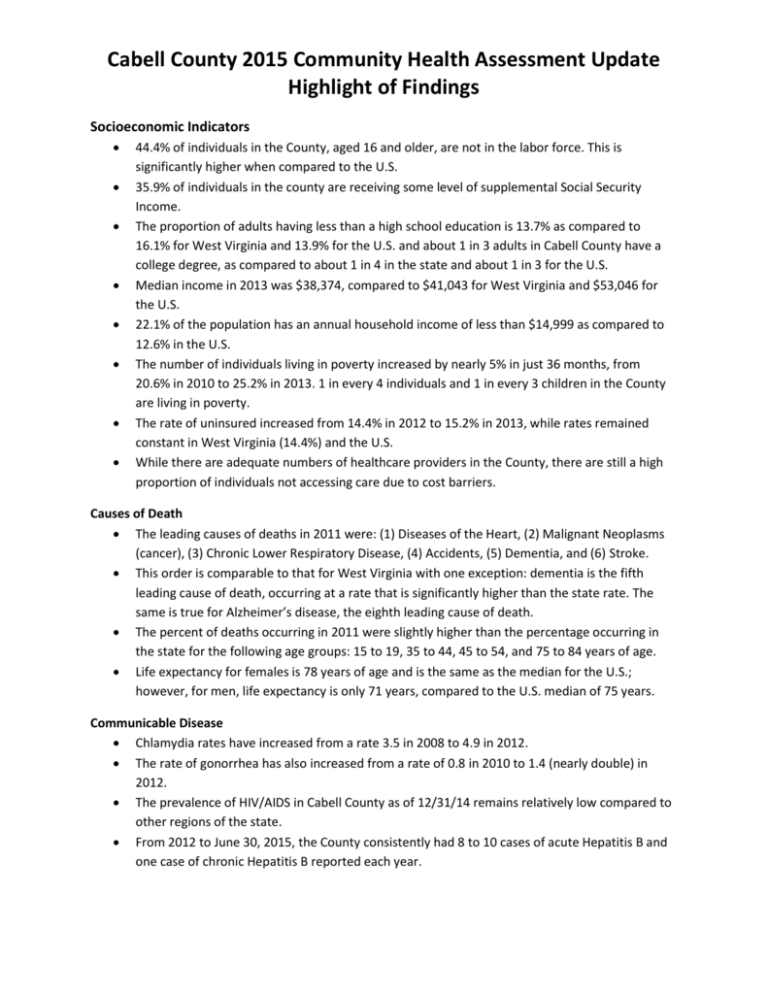2015 Community Health Assessment Highlights
advertisement

Cabell County 2015 Community Health Assessment Update Highlight of Findings Socioeconomic Indicators 44.4% of individuals in the County, aged 16 and older, are not in the labor force. This is significantly higher when compared to the U.S. 35.9% of individuals in the county are receiving some level of supplemental Social Security Income. The proportion of adults having less than a high school education is 13.7% as compared to 16.1% for West Virginia and 13.9% for the U.S. and about 1 in 3 adults in Cabell County have a college degree, as compared to about 1 in 4 in the state and about 1 in 3 for the U.S. Median income in 2013 was $38,374, compared to $41,043 for West Virginia and $53,046 for the U.S. 22.1% of the population has an annual household income of less than $14,999 as compared to 12.6% in the U.S. The number of individuals living in poverty increased by nearly 5% in just 36 months, from 20.6% in 2010 to 25.2% in 2013. 1 in every 4 individuals and 1 in every 3 children in the County are living in poverty. The rate of uninsured increased from 14.4% in 2012 to 15.2% in 2013, while rates remained constant in West Virginia (14.4%) and the U.S. While there are adequate numbers of healthcare providers in the County, there are still a high proportion of individuals not accessing care due to cost barriers. Causes of Death The leading causes of deaths in 2011 were: (1) Diseases of the Heart, (2) Malignant Neoplasms (cancer), (3) Chronic Lower Respiratory Disease, (4) Accidents, (5) Dementia, and (6) Stroke. This order is comparable to that for West Virginia with one exception: dementia is the fifth leading cause of death, occurring at a rate that is significantly higher than the state rate. The same is true for Alzheimer’s disease, the eighth leading cause of death. The percent of deaths occurring in 2011 were slightly higher than the percentage occurring in the state for the following age groups: 15 to 19, 35 to 44, 45 to 54, and 75 to 84 years of age. Life expectancy for females is 78 years of age and is the same as the median for the U.S.; however, for men, life expectancy is only 71 years, compared to the U.S. median of 75 years. Communicable Disease Chlamydia rates have increased from a rate 3.5 in 2008 to 4.9 in 2012. The rate of gonorrhea has also increased from a rate of 0.8 in 2010 to 1.4 (nearly double) in 2012. The prevalence of HIV/AIDS in Cabell County as of 12/31/14 remains relatively low compared to other regions of the state. From 2012 to June 30, 2015, the County consistently had 8 to 10 cases of acute Hepatitis B and one case of chronic Hepatitis B reported each year. Cabell County 2015 Community Health Assessment Update Highlight of Findings From 2012 to June 30, 2015, there was an increase in the number of confirmed cases of acute Hepatitis C. For cases of confirmed chronic Hepatitis C in individuals less than or equal to 25 years of age, the rate doubled from 2012 to 2013. Chronic Disease Prevlance The biggest increase in chronic disease has been asthma rates, which have increased from 7.9% to 11.3% in just three years. Rates of diabetes and arthritis have remained unchanged, but are still significantly higher than national rates. While rates of heart disease continue to decrease, rates remain significantly higher than national rates. There have been modest decreases in rates of breast, colon-rectal, lung, and prostate cancer. Behavioral Risk Factor Prevlance 1 in 3 people in Cabell County do not engage in regular physical exercise. In 2013, 84% of residents (nearly 9 out of every 10) were not eating 5 or more servings of fruits and vegetables daily. Intermediate Risk Factor Prevalence From 2010 to 2013, the percentage of the respondents rating their health status as fair or poor increased from 22.3% to 24.6%. In Cabell County, nearly 1 in 4 residents have no consistent source of primary care, consistent with state and national statistics. Obesity rates increased from 23.2% in 2001 to 33.2% (1 in 3) in 2013, while state and national rates have leveled off. Hypertension among county residents has increased from 31.7% in 2009 to 33.7% for combined years of 2009-2013 and nearly 20% of Cabell County residents with hypertension were not taking an antihypertensive medication. High cholesterol rates remain at about 41%. Quality of Life and Mental Health The total percent of adults reporting fair or poor health in Cabell County for 2006 to 2012 was 21.1%. 23.6% of the population in the region (1 in 4 people) has had some mental illness in the past year. 6.5% of the population in Region 5 (including Cabell County) has had a serious mental illness in the past year, compared to 5.9% for the state. The percentage of individuals having serious thoughts of suicide in Cabell County (2008-2010) was 4.0%, consistent with the percentage for the state of 4.2%. Cabell County 2015 Community Health Assessment Update Highlight of Findings Maternal Child Health 10.7% or more than 1 in every 10 newborns born in Cabell County are of low birthweight. Teen birth rates in Cabell County over the past 5 years have ranged from 43.9 to 48.3, while the U.S. had the lowest teen birth ever reported at 29.4 last year. In Cabell County in 2011, 24.9%, or 1 in every 4 pregnant women, used tobacco during pregnancy, compared to only 10.7% for the U.S. Cabell County is meeting Healthy People 2020 targets for the number of women receiving PAP screening tests. Addiction Most recent trends in tobacco use for Cabell County depict an increase in use from 25.2% in 2010 to 29.3% in 2011. For binge drinking, most recent data depicts a slight increase from 9.9 in 2008 to 11.0 for the combined years of 2009-2013; however, this rate is below both state and national rates. A significant increase in heroin use, property crimes, 911 calls, and deaths due to overdose have been well documented and are currently receiving significant attention. Overdose rates are far greater than rates reported in other cities across the country. Environmental Health 70% of Huntington residents live within ¾ of a mile of a park in the city itself, and 31% of people living in the county are located within one half mile from a park. In Cabell County, the annual average concentration of PM2.5 was 13.3. When compared to ‘like’ counties in the U.S., Cabell ranks in the least favorable quartile, and in fact, is ranked near the bottom of that quartile. Based on 2008-2012 combined data, in Cabell County, the percentage of homes built prior to 1950 was 32.7%, the percentage of homes built between 1950 and 1979 was 40.1%, and the percent of vacant residential properties was 12.3%. In Cabell County, only 3.3% of people who are low-income ‘do not’ live close to a grocery store. In Cabell County, the percent of the population living within 150 meters of a Highway in 2010 was 4.0%.







